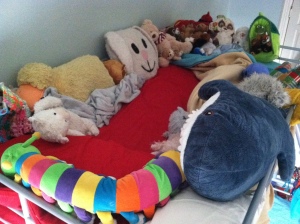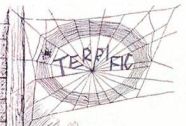My husband is Jewish and I was raised Catholic. Pre-nuptial imaginings of our future life together involved lots of talk about religion. And holidays.
We planned to raise our future-children Jewish, which meant we would celebrate Chanukah, but I knew that there were Christmas traditions that I couldn’t shed: the tree wasn’t particularly important to me, but the Advent calendar and Christmas stockings were. I loved the Advent calendars my mom got for us when I was a kid: simple, cardboard jobs with a little window you opened each day of December to reveal the sweet pictures hidden beneath. That daily reveal — and the repetitive cycle of anticipation and pleasure — mimicked the culminating experience of Christmas morning in miniature, and it was a joy.
We worked out a happy mish-mash, and once the kids came and were old enough to question our arrangement the line of reasoning we offered was that because I, their mother, was raised Catholic, Santa fills the stockings my mother knit for us. And because they are Jewish and celebrate Chanukah he doesn’t do additional big gifts for them. (Santa is nothing if not fair.)
As for the Advent calendar: the logic there — if you want to call it that — involves fairies and is much more tenuous. (To share it would be to heap doubt on the idea that I might be able to craft artful stories for children, so I won’t.)
I made an Advent calendar as a sort of embroidery sampler (each pocket attached to the base with a different stitch) when my children were young, and it has been home to an array of lovely things: beads, seashells, polished rocks, and painted acorns; miniature plates and bowls and doll furnishings; funny words, math puzzles, charms and fetishes; and, most recently, a menagerie of needle-felted and wooden animals to grace our Christmas tree (the kids prevailed upon us for this addition to the holiday repertoire a couple of years ago).
The items that go into the pockets of our calendar share one common characteristic: they are all SMALL.
Small things matter to little kids. When my daughters were little there was rarely an outing — neighborhood walk, playground visit, hike, or trip to the grocery store — that didn’t result in the bringing-home of special rocks. For a while small, sloppy cairns built up on various counters and shelves around the house, until finally on one late-night, dog-walking jaunt I pulled a huge old pickle jar out of the trash of a local deli and created a repository for the girls’ geological findings.
In addition to pebbles and rocks, my younger daughter had an eye for other tiny treasures too. At the end of days when she’d gone to a neighborhood playground or park, I’d find her pockets filled with countless odds and ends: pencil stubs, plastic-coated paper clips, limp pieces of deflated balloon, plastic hair clips and their parts, and little pieces of all sorts of trash. All brightly colored.
In the spring, flower heads and flower petals dominated the collections. And on especially lucky days she’d find what she termed “gem jewels” — those flattened glass marble things. Utility be damned: she was collecting bits of color and light. And she insisted her clothes conform: she required pockets. Every day.
The girls are now 9 and 11, and I still find rocks and acorns and the like in the laundry — though not with the same frequency. And to this day they still build amazing structures and worlds around and with their small things.
Last winter I discovered the Violet Mackerel series, a lovely set (currently six books strong) of beginning chapter books from Australian crafter (or “maker of things”), Sociology professor, and author Anna Branford. Violet is a 7 year-old, big-thinking, youngest-child with a strong attachment to small things. At the start of the series she lives with her single mom and two older siblings, and over the course of the books she negotiates moving house, expanding her family with a new parent, moody pre-adolescent siblings, making new friends, having her tonsils removed, and the like.
Written for early readers (1st or 2nd graders in the U.S.), the books address Violet’s struggles and challenges in ways that feel neither over-burdensome nor pat. In each story Violet develops and plays with a different theory relating to small things: the Theory of Finding Small Things, the Theory of Giving Small Things, the Theory of Helping Small Things, the Theory of Leaving Small Things Behind, etc. With these theories she negotiates and makes sense of the people and world she knows.
Through Violet Mackerel, Branford teases out and articulates the richness of the miniature worlds and small realities of early childhood. Offering us stories of how, through small things, one particular child comes to understand big ideas like caring, sharing and leaving, Branford gives language to the thinking and drives that are behind the way that young children relate to the small things they find and create. And she adds dimension to our own adult understanding too, which is no small thing at all.
















